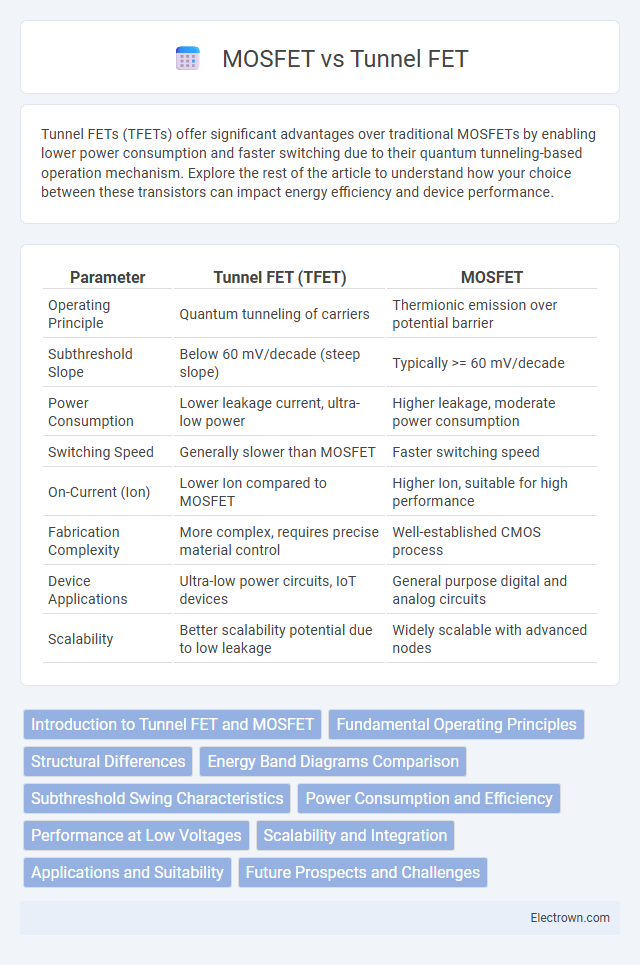Tunnel FETs (TFETs) offer significant advantages over traditional MOSFETs by enabling lower power consumption and faster switching due to their quantum tunneling-based operation mechanism. Explore the rest of the article to understand how your choice between these transistors can impact energy efficiency and device performance.
Table of Comparison
| Parameter | Tunnel FET (TFET) | MOSFET |
|---|---|---|
| Operating Principle | Quantum tunneling of carriers | Thermionic emission over potential barrier |
| Subthreshold Slope | Below 60 mV/decade (steep slope) | Typically >= 60 mV/decade |
| Power Consumption | Lower leakage current, ultra-low power | Higher leakage, moderate power consumption |
| Switching Speed | Generally slower than MOSFET | Faster switching speed |
| On-Current (Ion) | Lower Ion compared to MOSFET | Higher Ion, suitable for high performance |
| Fabrication Complexity | More complex, requires precise material control | Well-established CMOS process |
| Device Applications | Ultra-low power circuits, IoT devices | General purpose digital and analog circuits |
| Scalability | Better scalability potential due to low leakage | Widely scalable with advanced nodes |
Introduction to Tunnel FET and MOSFET
Tunnel FETs (TFETs) and MOSFETs are two distinct transistor technologies used in modern electronics, with MOSFETs being the conventional choice for switching and amplification in integrated circuits. TFETs leverage quantum tunneling to achieve low power consumption and steep subthreshold slope, making them promising for ultra-low-power applications where MOSFETs face limitations due to short-channel effects and leakage current. Understanding the fundamental differences in charge transport mechanisms between Tunnel FET and MOSFET can help optimize Your device design for specific performance and energy efficiency requirements.
Fundamental Operating Principles
Tunnel FETs operate based on quantum tunneling, allowing electrons to directly tunnel through the energy barrier between the source and channel, resulting in lower subthreshold swing and improved switching efficiency compared to traditional devices. MOSFETs rely on thermionic emission, where current flows due to carriers overcoming a potential barrier controlled by gate voltage, leading to higher power consumption at low voltage levels. Your choice between Tunnel FET and MOSFET impacts device scaling, power efficiency, and overall performance in nanoelectronic circuits.
Structural Differences
Tunnel FET (TFET) features a gate-controlled p-i-n structure that enables band-to-band tunneling for carrier injection, whereas MOSFET has a conventional metal-oxide-semiconductor capacitor structure relying on thermionic emission over a potential barrier. The source and drain regions in TFET are heavily doped with opposite types to create the tunneling junction, contrasting with MOSFET's uniformly doped source/drain regions forming a channel inversion layer. TFET's gate wraps around the intrinsic channel region to enhance tunneling efficiency, while MOSFET utilizes a planar or FinFET design focusing on controlling the inversion layer thickness.
Energy Band Diagrams Comparison
Tunnel FETs (TFETs) exhibit a unique energy band diagram characterized by band-to-band tunneling at the source-channel junction, enabling lower subthreshold swings and reduced power consumption compared to traditional MOSFETs, which rely on thermionic emission over a potential barrier. The MOSFET energy band diagram shows a significant energy barrier between the source and channel, leading to higher off-state leakage currents and limited gate control at low voltages. Your choice of TFET technology can enhance energy efficiency, especially in low-power applications, due to its steeper energy bands and more efficient carrier injection mechanisms.
Subthreshold Swing Characteristics
Tunnel FETs exhibit significantly steeper subthreshold swing characteristics compared to MOSFETs, often achieving values below the 60 mV/decade thermal limit at room temperature. This reduced subthreshold swing enables Tunnel FETs to switch at lower voltages, enhancing energy efficiency in low-power applications. MOSFETs typically experience a higher subthreshold swing, leading to greater leakage currents and less efficient switching behavior in ultra-scaled devices.
Power Consumption and Efficiency
Tunnel FETs offer significantly lower power consumption than MOSFETs due to their steep subthreshold slope, enabling operation at lower voltages and reduced leakage currents. This improved switching efficiency makes Tunnel FETs ideal for ultra-low-power applications, extending battery life in portable devices. Your choice between Tunnel FET and MOSFET depends on prioritizing energy efficiency over switching speed in semiconductor design.
Performance at Low Voltages
Tunnel FETs (TFETs) demonstrate superior performance at low voltages compared to traditional MOSFETs due to their ability to achieve steep subthreshold slopes below 60 mV/decade, enabling lower power consumption and reduced leakage currents. Unlike MOSFETs, which suffer from increased short-channel effects and higher threshold voltages at scaled voltages, TFETs utilize band-to-band tunneling mechanisms that maintain high ON-state currents even at voltages below 0.5 V. This makes TFETs highly suitable for ultra-low-power applications in energy-efficient integrated circuits and IoT devices.
Scalability and Integration
Tunnel FETs offer superior scalability compared to traditional MOSFETs due to their lower subthreshold slope and reduced leakage currents, enabling continued miniaturization beyond 5 nm technology nodes. Their compatibility with existing CMOS fabrication processes facilitates easier integration into current semiconductor manufacturing workflows. MOSFETs still dominate high-performance applications, but Tunnel FETs provide promising energy-efficient alternatives for ultra-scaled integrated circuits in IoT and low-power devices.
Applications and Suitability
Tunnel FETs (TFETs) offer significant advantages in low-power applications such as wearable electronics and IoT devices due to their steep subthreshold slope and reduced leakage current. MOSFETs remain dominant in high-speed and high-frequency applications including microprocessors and power amplifiers, benefiting from mature fabrication technology and higher drive current. The suitability of TFETs or MOSFETs depends largely on power efficiency requirements and operating voltage ranges within specific electronic systems.
Future Prospects and Challenges
Tunnel FETs (TFETs) offer significant potential for ultra-low power applications due to their steep subthreshold slope and reduced leakage current, positioning them as promising alternatives to traditional MOSFETs in energy-efficient computing. However, challenges such as limited drive current, fabrication complexity, and variability in material quality hinder large-scale integration and commercial viability. Continued advancements in novel materials like 2D semiconductors and improved device architectures are critical for overcoming these obstacles and enabling TFETs to complement or replace MOSFET technology in future nanoelectronics.
Tunnel FET vs MOSFET Infographic

 electrown.com
electrown.com